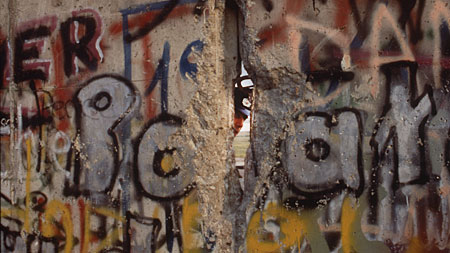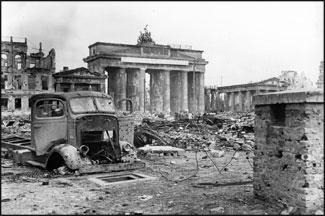I was born in the northern part of what was then West Germany two years after the end of World War II. I was lucky because the war was over. But I felt like I experienced the war through my parents' and siblings' stories. And I saw what war did to Germany. Some of my first memories are of the destruction that was all around when I was growing up. There were endless stories of people, particularly kids, having their arms and legs blown up by unexploded ordinances as they dug through the rubble for salvageable building materials and household items. My father, who had spent time on the Russian front and in a British prisoner of war camp, had been deeply effected by the war, to the point that he never really recovered, mentally. My mother, too, had suffered during the war. She lost a young son, almost all of her family, and everything that the family owned. She came from a prosperous Prussian family and thought of herself as an aristocrat. She spent some of her summers in Berlin, and others at a large seaside resort that her favorite aunt and uncle owned, going to summer dances and grand balls. At one point my father, an ordained minister, was working as a social worker while we were still living in Germany. (We came to the U.S. when I was seven.) One of his duties was to meet planes full of teenage boys who had escaped from East Berlin into West Berlin, at the Hanover Airport. We would meet them at the plane and take them to a boys camp a few hours to the north. That was in the early 1950's. It was quite a long time before I had the opportunity to go to Berlin myself, but I always had a certain fascination for the city. I had gone back to West Germany a number of times to handle different assignments, cover trade shows and do travel articles for an in-flight magazine I was contributing to, but that airline didn't fly to Berlin. I was waiting for some paid opportunity or assignment to go there, but the opportunity to go there never quite presented itself. Finally, in the early 1980's, I decided I had better head there on my own if I was ever to get there. Once I spent some time there, I wound up going back as often as possible. It was everything I had expected and more. I kicked myself for having waited that long. When I first started going there, it still had a certain World War II feeling about it. Templehof, the airport that was the heart of the Berlin Airlift, was still in commercial operation. It reminded me very much of Hanover Airport of the 1950's. At the same time, Berlin was the city where the Cold War was being played out every day. Places like Checkpoint Charlie, Brandenburg Gate, Potsdamer Platz, and the abandoned Reichstag, all highlighted the intersection of WWII and the Cold War. There was international intrigue and suspense in the air. When Berlin was still divided, I had the opportunity to go into East Berlin a number of times, and I frequently took the U-Bahn (the subway) through the Eastern sector. One of the most interesting aspects to that trip were the Ghost Stations. Under the U.S., French, British and Soviet Four Powers pact that governed Berlin, there was supposed to be unhindered transportation access to all parts of the city by both the U-Bahn, the West Berlin subway system, and the S-Bahn, the East Berlin elevated system. While Westerners could get off at Alexanderplatz in the heart of East Berlin, which was a transfer point for both systems, the station was sealed off from access for East Berliners, so no locals got to use either system. Ghost Stations were subway stops under East Berlin that were supposed to be accessible and operational, but weren't. Armed East German border guards with vicious looking German shepherds patrolled the dimly lit platforms, making sure that any East Berliner who might have somehow made it into the station wasn't jumping onto the slow moving subway cars as they pulled through. It was very reminiscent of a World War II scene. Going through the stations with the police and dogs kind of made you think you might just see some people in the distance being herded off onto cattle cars to be transported to the Gulag. Taking the S-Bahn was also interesting. It gave you an elevated look at East Berlin without ever having to actually go into that sector. That's how many people visiting Berlin, including myself, first saw that part of the city. The first time I came to West Berlin, the city was quite tense. The section between the two parts of the city (in the shot looking down the wall) was referred to by Berliners as the Todes Sterifen, or death strip. It was heavily mined, and East German Guards had shoot-to-kill orders for anybody who even tried to go across. I can remember looking through my telephoto lens at an East German border guard with binoculars in one of the watch towers, keeping a close eye on what I was doing. It made me a little nervous, but it really shouldn't have. The guards didn't shoot across the border at West Berliners, just at East Germans who might try to escape. (The Museum at Checkpoint Charlie is dedicated to all the people who lost their lives trying to escape the tyranny of Communism, and to those lucky ones who made it to the other side in so many ingenious ways. Unfortunately, the Checkpoint Charlie that's there now is a recreation. The original one was taken down soon after the opening of the Wall.) By the late 1980's things had relaxed a little. But that didn’t mean there weren’t still dangers. The last person to be killed by East German border guards trying to escape, Chris Geoffroy, was shot on June 2nd, 1989, just five months before the Wall fell. It was the more relaxed attitude of the time that actually led to his death. Because things were more relaxed between the two Berlins, he believed that the shoot-to-kill order was no longer in effect. Unfortunately, it still was.
An East German border guard looking through a chiseled hole.
| A look back at Berlin |
||
|
|||
Historical photo |
|||
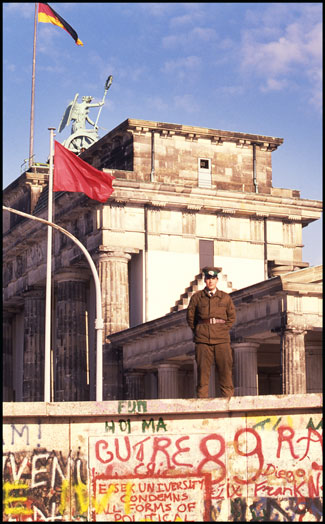 |
|||
An East German Border Guard patrolling on top of the Wall. |
|||
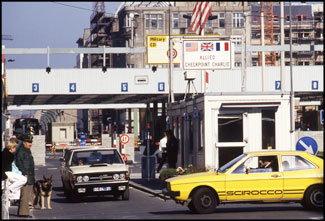 |
|||
Checkpoint Charlie... the best know of the checkpoints heading into East Berlin. |
|||
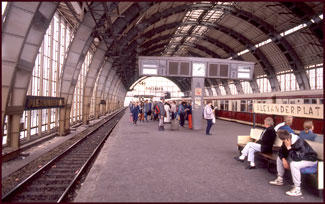 |
|||
Alexanderplatz was one of the major commercial centers of pre-war Berlin and the transportation hub of East Berlin. |
|||
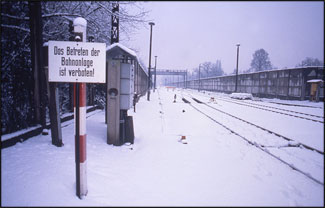 |
|||
The tracks leading into West Berlin. (West German trains were closely inspected in the very long concrete corridor, to make sure that no one had stowed away while they were traveling through East Germany). |
|||
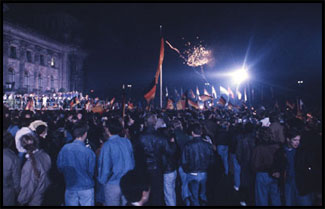 |
|||
German's celebrating reunification at the Reichstag, October 3, 1990. |
|||
| Slide Show with more images | |||

